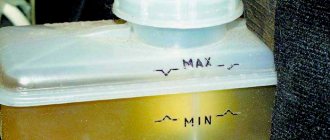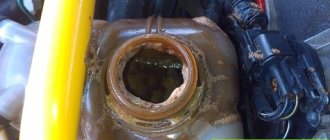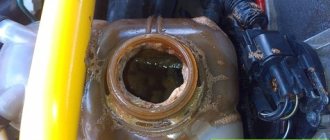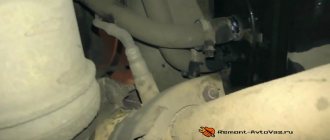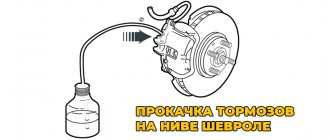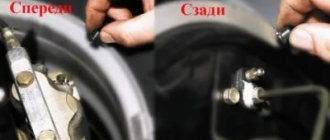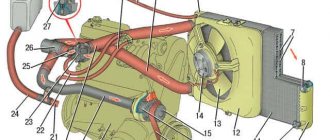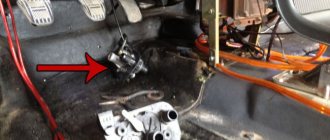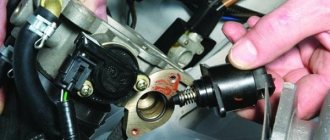The design of the VAZ 2107 car uses a braking system, on the serviceability of which the safety of the driver and passengers depends. This system consists of a large number of different parts, and an important role is assigned to the brake fluid reservoir of the VAZ 2107. This is a special container into which a special liquid mass is poured, which takes an active part in the operation of the system.
Where should I pour the liquid?
In order to fill this same liquid, you first need to find a tank for it. By the way, many cannot find it the first time and without outside help. Before you fill in a new fuel fluid, you need to get rid of the old one. To do this, use a syringe or similar means to clean the tank, and then use any clean cloth to remove the remaining sediment on its bottom and walls.
It is clear that this liquid must be poured very carefully, since contact with the exterior paint of the car can lead to damage. If you do not properly clean the reservoir of the previous brake substance, then small particles such as dust in the future may well cause a complete failure of the corresponding system. If the level of the substance in the reservoir is low, it is necessary to immediately check the integrity of the brake hose, as the cause may be a leak.
In general, the braking system is considered closed, although air enters it when the brake pedal is pressed, but it is completely pushed out when it is smoothly released. This feature of the system allows the liquid to be stored for a very long time and it is recommended to replace it only after two or even three years.
It's no secret that all substances need timely replacement. All necessary data is usually collected in the vehicle's operating manual. In addition to time, another factor in the need to replace brake fluid is mileage.
After driving forty thousand kilometers, you need to at least check the serviceability of the braking system.
Brake fluid reservoir location
The brake fluid reservoir is located in the engine compartment of the vehicle. In order to see it, you need to open the hood. The tank is usually located in an easily accessible, visible place. This is due to the fact that during the operation of the car the brake fluid level should be periodically monitored, topped up or changed.
ATTENTION! A completely simple way to reduce fuel consumption has been found! Don't believe me? An auto mechanic with 15 years of experience also didn’t believe it until he tried it. And now he saves 35,000 rubles a year on gasoline! Read more"
Brake fluid reservoir location
Still, there are cars where the tank is not so easy to detect. It is hidden in the depths of the engine compartment and is often covered with decorative panels, other components or parts. To find the tank in this case, it is recommended to refer to the technical description of the specific car.
Brake fluid reservoir hidden from easy access
How to find it in Hyundai?
When using a Hyundai car, you need to periodically check the volume of brake fluid. If necessary, add fluid to the tank. The reservoir into which the brake fluid must be filled is located on the main cylinder, on the left side of the engine compartment.
In order to avoid the costs of repairing the brake system, or even the entire car, in the future, change the used working fluid with a new one in a timely manner . Brake fluid is highly hygroscopic (absorbs moisture from the air). This not only increases the corrosive effect on spare parts, but also reduces the boiling point of the liquid itself. This may cause the braking system to stop working. Do not re-apply the drill. It contains too much dirt, air and moisture.
We recommend: 22 best diesel cars
Purpose of the container
The design of the domestic VAZ 2107 car uses a hydraulic braking system, consisting of drive and actuator mechanisms, as well as lines in the form of tubes and hoses, and a reservoir filled with liquid. This liquid substance acts as a drive source, and it is called brake fluid - an acid that is hygroscopic. It is poured into a transparent plastic container under the hood, but more on that.
The container in question on the seven is made of soft and impact-resistant plastic. It is almost impossible to break the tank, but it is easy to damage it with a sharp tool. The reservoir is filled with fluid, which goes to the master cylinder. The piston moves in the cylinder when the middle pedal is pressed, thereby increasing the pressure in the system. When the pressure increases, the working cylinders are activated, in which the pistons move under the action of a liquid substance.
From a brief description of the principle of operation of the brake system on the VAZ 2107, it is clear that the reservoir plays a fundamental role. It ensures an uninterrupted supply of working substance to the main cylinder of the system. If lines or operating mechanisms are damaged, the tightness of the system is compromised. Due to the fact that the tank has transparent walls, it is possible to identify system malfunctions easily and quickly. To do this, you need to open the hood and look to see if the container is full.
How to change the tank
Before replacing the brake fluid reservoir, you need to understand its location. The reservoir is located on the driver's side under the hood. When you open the hood, you need to look at the wall closest to the cabin, where there will be two plastic tanks next to each other. The first reservoir, which is located to the left, is a container for brake fluid. Next to this tank there is another tank of a smaller volume - this is a container for a similar substance, which is used in the clutch system.
Vehicle owners should be aware that brake fluid must be replaced every 40 thousand km. If the car has mileage above this indicator, then the quality of the mixture deteriorates, which can cause brake failure at any time. In addition to replacing the mixture every 40,000 km, it is also necessary to periodically monitor the level of brake fluid in the reservoir and, if necessary, top it up.
Bleeding the brakes: step-by-step instructions
To better pump the brakes of the “Seven” you will need an assistant. One will be under the car and work on the brake cylinders, while the other presses the brake pedal inside the car. The following tools will be useful in your work:
- head for 8 and 10 caps;
- head for 8 and 10, open-end or for brake pipes;
- transparent container for waste;
- hose of the required diameter.
Pumping starts from the furthest tire from the GTZ, therefore, start from:
- right rear tire;
- left rear;
- right front;
- left front.
To bleed the rear tire brakes, go under the car. All work related to the front brakes is carried out after the tires have been removed in advance. Otherwise the procedure is identical:
- Remove the protective cap from the brake cylinder fitting. Loosen the fitting slightly with an 8 and 10 mm wrench.
- Connect the hose to the fitting and place the opposite end into a container.
- Press the brake pedal until hardness appears and keep it pressed.
- Unscrew the fitting half a turn. The fuel fluid will begin to flow out of the hose, the pedal is pressed to the floor. Do not release the pedal until the liquid stops oozing.
- Tighten the fitting and repeat the process until liquid and air come out of the tube.
- Repeat the manipulations with the remaining tires of the VAZ-2107. To bleed the front brake, simply remove the wheel.
- To complete the pumping, close the fitting with a rubber cap. During pumping, you should monitor the fluid level in the expansion tank. It is important that there is no air in the system.
Fluid replacement tips
Now that we have figured out where exactly it is necessary to fill the fuel fluid, the next step is to choose between contacting the service or replacing it on our own, but not without an assistant. Of course, every more or less high-quality and serious car service center has all the necessary equipment to perform such a braking operation. Thus, the replacement time will be no more than twenty minutes, and its cost will not be too high. Manual replacement takes up to two hours.
Having determined where the brake fluid reservoir is located, first of all, use a tester to check its quality. For example, electronic testers immediately show the boiling point of the fuel fluid, and if it exceeds one hundred and seventy-five degrees Celsius, then everything is fine, but if it is below one hundred and sixty-five, then things are bad and intervention is required.
You also cannot do without an instruction manual, because each car has its own characteristics, and thanks to it you will understand how and where to fill the fluid. But you need to understand that if your car does not include an ABC or a block of corresponding ABC hydraulic valves in its structure, the hydraulic accumulator and pump itself are a single unit, manual intervention is quite possible. If you have an integral type ABC, it is best to visit a car service center.
We recommend: Filling and lubrication work
Replacing an old vehicle with a new one is carried out carefully and one by one in the circuits of the vehicle. The first in line for this process is the wheel located away from the main cylinder of the vehicle. Therefore, there is a parallel circuit diagram and a diagonal one. The first is a replacement of the TJ in the right rear wheel, left rear, right front and left front. As for the diagonal scheme, the procedure is carried out diagonally: right rear - left front and left rear - right front.
Before adding new fluid, all wheels must be removed, and the car itself must be placed over a pit for inspection. Using a jack, you can also carry out all stages of repair, but the convenience of the process directly depends on the position of the brake cylinder bleeder fittings.
Having removed the wheels and figured out where to fill the brake fluid, the next step is to pour it into the reservoir to the full line and replace the cap. After this, you need to pump the brakes by pressing the pedal at least fifteen times so that the fuel fluid spreads throughout the entire system.
In general, for a complete repair it is necessary not only to find out where the brake fluid reservoir is located, but also to acquire the following things:
- Two pairs of stand-up goats;
- Box type wrench;
- Completely clean plastic pipe;
- High-quality TZ;
- A syringe or other suction device;
- Brake cleaner;
- Clean and fairly soft fabric;
- Container for old liquid;
- WD-40.
How to bleed your brakes yourself?
There are several ways, we’ll talk about each specifically.
Method 1 – lid with nipple
For this method we will need to make one “homemade product”. We take an unnecessary cap from the brake fluid reservoir or from the clutch reservoir (the caps have the same thread and diameter). We buy a nipple for the camera and unscrew the nipple from it. We make a hole in the lid to secure the purchased nipple in it. We carefully glue it to avoid air leakage from the attachment points.
Video on how to make it:
We take a hose whose inner diameter should match the diameter of the nipple on the lid. The length should be enough to reach them from the barrel to the car wheel. Let's start the process.
- Remove the cap with the level sensor from the brake fluid reservoir. Screw in the homemade product instead
- We take a hose and put it on the nipple of a homemade lid
- We clamp the hose with a clamp or other fastener. This will help control the air supply in the barrel. You need to create pressure - release the clamp, no - clamp the hose
- We unscrew the nipple from the left front wheel or spare tire. We put a hose on it. It is advisable to keep the pressure in the wheel chamber at about 2 atm.
- We release the clamp and go to bleed the brakes ourselves according to the scheme outlined at the beginning of the article.
- Having bled the air from their system, we disassemble the circuit. Don’t forget to return the original cap with the level sensor to the brake barrel.
This method is good if you need to pump one of the elements of the system where the amount of air is small. Do not forget that when pumping, you always need to monitor the level of brake fluid in the barrel. Therefore, if you pump the entire system in this way, then you will have to constantly unscrew the cap and check the level and top it up if necessary. This is where a clamp comes in handy so as not to release all the pressure from the chamber. Agree, this is inconvenient.
Method 2 - gas stop or stick
I do everything the same as with an assistant. Only instead of his leg we use improvised means: a gas stop, if the car has one, or a stick of suitable length. We independently press the pedal several times and press it with what you have. You can rest it on the driver's seat so that the brake always remains pressed. We climb into the hole and pump up what you need.
Important! With this method, when you unscrew the cylinder bleeder fitting, the pressure in the system will drop and there is a possibility that the stick or stop will come off the pedal. It will return to its original position. This is fraught with air being sucked into the system through the fitting you opened. This is suitable for bleeding air from one specific brake mechanism; it is not suitable for the entire system.
Where is the brake fluid reservoir located?
In the domestic VAZ car, the brake fluid reservoir is located in the engine compartment (on the left) and is secured with a clamp to the partition. A decrease in the volume of working fluid in the reservoir when the hydraulic brake drive system is sealed is a sign of worn out pads.
Knowing where the brake fluid reservoir is located, you can easily replace the brake fluid with fresh fluid. Remember to replace regularly. Thanks to this, you can maximize the operating life of your own machine.
Brake hoses: replacement
If the car owner notices smudges resulting from tire wear, it is necessary to change the brake hoses. Technical literature says that hoses installed more than 3 years ago are prohibited from being used. The explanation for this is simple: firstly, rubber ages, and secondly, it is more susceptible to deformation.
In a VAZ-2107 car, brake hoses are located both at the front and at the rear. These components lead the fluid fluid to the working cylinders. Having found out that the rubber component requires replacement, you need to stock up on:
- screwdrivers;
- pliers;
- a set of keys;
- new hose;
- brake fluid.
